Petrology and Geochemistry Features of the Middle Triassic Anisian Shale in Sichuan Basin, South China: Implications for Climatic and Environmental Condition Change
Abstract
1. Introduction
2. Geological Setting and Stratigraphy
3. Samples and Methods
3.1. XRD
3.2. Major and Trace Elemental Analysis
3.3. TOC
3.4. Nitrogen and Organic Carbon Isotopes
3.5. Proxy Calculations
4. Results
4.1. Lithology and Mineralogy
4.2. Isotopic and Elemental Geochemistry
4.3. Terrigenous Fluxes
4.4. Organic Geochemistry
4.4.1. Organic Matter Abundance and Maturity
4.4.2. Kerogen Components
4.4.3. Kerogen Carbon Isotopes
4.4.4. Biomarkers
Normal Alkanes
Sesquiterpanes
Terpanes
Steroids
5. Discussion
5.1. Organic Geochemical Characteristics
5.1.1. Hydrocarbon Generation Potential
5.1.2. Organic Matter Sources
5.2. Depositional Environment
5.2.1. Paleo-Weathering and Recycling Processes
- (1)
- Sediment recycling and sorting
- (2)
- Post-depositional diagenetic alteration
5.2.2. Marine Redox Conditions
- (1)
- Organic carbon isotope δ13Corg
- (2)
- δ15Norg isotope
- (3)
- Elemental geochemistry
5.2.3. Paleoproductivity
- (1)
- Organic carbon isotope (δ13Corg)
- (2)
- Elemental geochemistry
5.2.4. Water Salinity
5.3. Water Column Restriction
5.3.1. Mo/TOC Pattern
5.3.2. MoEF-UEF Covariant Model
5.4. Depositional Model for Organic Matter Accumulation
6. Conclusions
- The depositional environment evolved from a productive, anoxic system (mixed shale) to a less productive, dysoxic one (calcareous shale), concurrent with a climatic shift from warm-humid to sub-humid conditions. This transition is consistently recorded by geochemical proxies for redox (e.g., V/Cr, U/Th), productivity (Pxs, Baxs), and weathering (CIA).
- Regional tectonic uplift, associated with the Indosinian Orogeny, is identified as the primary driver of this evolution. It induced a sea-level fall, enhanced physical weathering, increased basin restriction, and moderated the climate, thereby orchestrating the observed facies succession. This finding supports a tectonically modulated depositional model for organic matter accumulation.
- The mixed shale facies, characterized by the highest residual TOC content and deposition under the most favorable environmental conditions, is identified as the most promising interval for shale gas exploration.
Author Contributions
Funding
Data Availability Statement
Acknowledgments
Conflicts of Interest
References
- Bottjer, D.J.; Clapham, M.E.; Fraiser, M.L.; Powers, C.M. Understanding mechanisms for the end-Permian mass extinction and the protracted Early Triassic aftermath and recovery. GSA Today 2008, 18, 4–10. [Google Scholar] [CrossRef]
- Alroy, J. Dynamics of origination and extinction in the marine fossil record. Proc. Natl. Acad. Sci. USA 2008, 105, 11536–11542. [Google Scholar] [CrossRef] [PubMed]
- Lehrmann, D.J.; Jiayong, W.; Enos, P. Controls on facies architecture of a large Triassic carbonate platform; the Great Bank of Guizhou, Nanpanjiang Basin, South China. J. Sediment. Res. 1998, 68, 311–326. [Google Scholar] [CrossRef]
- Lehmann, M.F.; Bernasconi, S.M.; Barbieri, A.; McKenzie, J.A. Preservation of organic matter and alteration of its carbon and nitrogen isotope composition during simulated and in situ early sedimentary diagenesis. Geochim. Cosmochim. Acta 2002, 66, 3573–3584. [Google Scholar] [CrossRef]
- Lehrmann, D.J.; Stepchinski, L.; Altiner, D.; Orchard, M.J.; Montgomery, P.; Enos, P.; Ellwood, B.B.; Bowring, S.A.; Ramezani, J.; Wang, H.; et al. An integrated biostratigraphy (conodonts and foraminifers) and chronostratigraphy (paleomagnetic reversals, magnetic susceptibility, elemental chemistry, carbon isotopes and geochronology) for the Permian–Upper Triassic strata of Guandao section, Nanpanjiang Basin, South China. J. Asian Earth Sci. 2015, 108, 117–135. [Google Scholar] [CrossRef]
- Ovtcharova, M.; Goudemand, N.; Hammer, Ø.; Guodun, K.; Cordey, F.; Galfetti, T.; Schaltegger, U.; Bucher, H. Developing a strategy for accurate definition of a geological boundary through radio-isotopic and biochronological dating: The early–middle Triassic boundary (South China). Earth-Sci. Rev. 2015, 146, 65–76. [Google Scholar] [CrossRef]
- Li, C. Origin and Geological Significances of Claystone (Mung BeanRock) in the Early-Middle Triassic Boundary, Western Margin of Sichuan Basin. Master’s Thesis, Chengdu University of Technology, Chengdu, China, 2021. (In Chinese). [Google Scholar]
- Sun, S.; Li, J.L.; Chen, H.H.; Peng, H.; Hsü, K.J.; Shelton, J.W. Mesozoic and Cenozoic sedimentary history of South China. AAPG Bull. 1989, 73, 1247–1269. [Google Scholar] [CrossRef]
- Zeng, H. Sedimentation and hydrocarbon potential of early triassic carbonate rocks of shiwan dashan basin in guangxi. Prtroleum Geol. Exp. 1984, 2, 95–100. (In Chinese) [Google Scholar]
- Sun, Y.D. Paleoclimate Impact and Biodiversity Response of Volcanism at the Paleo-Mesozoic Transition in South China. Ph.D. Thesis, China University of Geosciences, Wuhan, China, 2013. (In Chinese). [Google Scholar]
- Wang, Y.; Jiang, W.; Liu, H.; Liu, B.; Zheng, H.; Song, X.; Wang, Q.; Wang, W.; Li, Y. Sedimentary and Diagenetic Features and Their Impacts on Microbial Carbonate Reservoirs in the Fourth Member of the Middle Triassic Leikoupo Formation, Western Sichuan Basin, China. Energies 2020, 13, 2293. [Google Scholar] [CrossRef]
- Sun, H.F.; Luo, B.; Wen, L.; Wang, J.X.; Zhou, G.; Wen, H.G.; Huo, F.; Dai, X.; He, C.L. The first discovery of organic-rich shale in Leikoupo Formation and new areas of subsalt exploration, Sichuan Basin. Nat. Gas Geosci. 2021, 32, 233–247. [Google Scholar]
- Boucot, A.J.; Chen, X.; Scotese, C.R.; Fan, J.X. Phanerozoic Paleoclimate: An Atlas of Lithologic Indicators of Climate; Science Press: Beijing, China, 2009; Volume 1, pp. 90–102. (In Chinese) [Google Scholar]
- Chen, X.; Boucot, A.J.; Scotese, C.R.; Junxuan, F.; Yuan, W.; Xiujuan, Z. Pangaean aggregation and disaggregation with evidence from global climate belts. J. Palaeogeogr. 2012, 1, 5–13. [Google Scholar]
- Scotese, C.R. Paleomap Website. 2002. Available online: http://www.scotese.com (accessed on 5 May 2022).
- Tabor, N.J.; Poulsen, C.J. Palaeoclimate across the Late Pennsylvanian-Early Permian tropical palaeolatitudes: A review of climate indicators, their distribution, and relation to palaeophysiographic climate factors. Palaeogeogr. Palaeoclimatol. Palaeoecol. 2008, 268, 293–310. [Google Scholar] [CrossRef]
- Dobson, J.P.; Heller, F. Triassic paleomagnetic results from the Yangtze Block, SE China. Geophys. Res. Lett. 1993, 20, 1391–1394. [Google Scholar] [CrossRef]
- Lin, Y.T.; He, J.Q. Study on palaeomagnetism and salt formation conditions of the stratum of Lower-Middle Trias Series (Tlj–T2j) of Sichuan Basin. J. Salt Lake Res. 2005, 13, 1–4, (In Chinese with English abstract). [Google Scholar]
- Opdyke, N.D.; Huang, K.; Xu, G.; Zhang, W.Y.; Kent, D.V. Paleomagnetic results from the Triassic of the Yangtze Platform. J. Geophys. Res.-Solid Earth Planets 1986, 91, 9553–9568. [Google Scholar] [CrossRef]
- Wu, H.; Zhu, R.; Bai, L.; Guo, B.; Lv, J.J. Revised apparent polar wander path of the Yangtze Block and its tectonic implications. Sci. China 1998, 41, 78–90. [Google Scholar]
- Zhu, R.X.; Yang, Z.Y.; Wu, H.N.; Ma, X.H.; Huang, B.C.; Meng, Z.F.; Fang, D.J. Paleomagnetic constraints on the tectonic history of the major blocks of China duing the Phanerozoic. Sci. China 1998, 41, 1–19. [Google Scholar]
- Guo, Z.W.; Deng, K.L.; Han, Y.H. The Formation and Development of Sichuan Basin; Geological Publishing House: Beijing, China, 1996; pp. 1–200. (In Chinese) [Google Scholar]
- He, D.F.; Li, D.S.; Zhang, G.W.; Zhao, L.Z.; Fan, C.; Lu, R.Q.; Wen, Z. Formation and evolution of multi-cycle superposed Sichuan Basin, China. Chin. J. Geol. 2011, 46, 589–606, (In Chinese with English abstract). [Google Scholar]
- Meng, Q.R.; Wang, E.; Hu, J.M. Mesozoic sedimentary evolution of the northwest Sichuan basin: Implication for continued clockwise rotation of the South China block. Geol. Soc. Am. Bull. 2005, 117, 396–410. [Google Scholar] [CrossRef]
- Enos, P.; Wei, J.; Lehrmann, D.J. Death in Guizhou-Late Triassic drowning of the Yangtze carbonate platform. Sediment. Geol. 1998, 118, 55–76. [Google Scholar] [CrossRef]
- Xu, X.D.; Liu, B.J. Sequence Boundary and Sea Level Changes in Western Margin of Upper Yangtze Platform during Permian and Triassic. J. China Univ. Geosci. 1996, 7, 105–111. [Google Scholar]
- Koenig, I.; Lougear, A.; Bruns, P.; Gruetzner, J.; Trautwein, A.X.; Dullo, W.C. Iron oxidation in sediment cores (Site 1062) during six months of storage in the Ocean Drilling Program archive. In Proceedings of the Ocean Drilling Program Scientific Results; 2001; Volume 172, pp. 25–35. Available online: https://www-odp.tamu.edu/publications/172_SR/chap_02/chap_02.htm (accessed on 13 November 2025).
- Li, S.G.; Hart, S.; Zheng, S.G.; Liu, D.L.; Zhang, G.W.; Guo, A.L. Sm-Nd isotopic evidences of collision between North China plate and South China plate. Sci. China (Ser. B) 1989, 3, 312–319, (In Chinese with English abstract). [Google Scholar]
- Li, S.G.; Sun, W.D.; Zhang, G.W.; Chen, J.Y.; Yang, Y.C. Chronology and geochemistry of metavolcanic rocks from Heigouxia Valley in the Mian-Lüe tectonic zone, South Qinling-Evidence for a Paleozoic oceanic basin and its close time. Sci. China (Ser. D) 1996, 39, 300–310. [Google Scholar]
- Meng, Q.; Zhang, G. Timing of collision of the North and South China blocks: Controversy and reconciliation. Geology 1999, 27, 123. [Google Scholar] [CrossRef]
- Zhang, G.W. Orogenesis and dynamics of the Qinling Orogen. Sci. China 1996, 3, 225–234. [Google Scholar]
- Chu, Y.; Faure, M.; Lin, W.; Wang, Q. Early Mesozoic tectonics of the South China block: Insights from the Xuefengshan intracontinental orogen. J. Asian Earth Sci. 2012, 61, 199–220. [Google Scholar] [CrossRef]
- Chu, Y.; Faure, M.; Lin, W.; Wang, Q.; Ji, W. Tectonics of the Middle Triassic intracontinental Xuefengshan Belt, South China: New insights from structural and chronological constraints on the basal décollement zone. Int. J. Earth Sci. 2012, 101, 2125–2150. [Google Scholar] [CrossRef]
- Wang, Y.; Fan, W.; Zhang, G.; Zhang, Y. Phanerozoic tectonics of the South China Block: Key observations and controversies. Gondwana Res. 2013, 23, 1273–1305. [Google Scholar] [CrossRef]
- Zhang, G.; Guo, A.; Wang, Y.; Li, S.; Dong, Y.; Liu, S.; He, D.; Cheng, S.; Lu, R.; Yao, A. Tectonics of South China continent and its implications. Sci. China 2013, 56, 1804–1828. [Google Scholar] [CrossRef]
- Faure, M.; Lin, W.; Chu, Y.; Lepvrier, C. Triassic tectonics of the southern margin of the South China Block. Comptes Rendus Geosci. 2016, 348, 5–14. [Google Scholar] [CrossRef]
- Huang, H.; He, D.; Li, Y.; Fan, H. Determination and formation mechanism of the Luzhou paleo-uplift in the southeastern Sichuan Basin. Earth Sci. Front. 2019, 26, 102–120. [Google Scholar]
- Feng, Z.Z.; Bao, Z.D.; Shenghe, W.; Yongtie, L.; Guoli, W. Lithofacies paleogeography of the early and middle triassic of south china. Chin. J. Geol. 1997, 2, 212–220. (In Chinese) [Google Scholar]
- Yin, H.F. Discussion on the lainian stage in china. Geol. Rev. 1982, 28, 235–239. (In Chinese) [Google Scholar]
- Benton, M.J.; Zhang, Q.; Hu, S.; Chen, Z.Q.; Wen, W.; Liu, J.; Huang, J.; Zhou, C.; Xie, T.; Tong, J.; et al. Reprint of “Exceptional vertebrate biotas from the Triassic of China, and the expansion of marine ecosystems after the Permo-Triassic mass extinction”. Earth-Sci. Rev. 2014, 137, 85–128. [Google Scholar] [CrossRef]
- SY/T5163-2010; Analysis Method for Clay Minerals and Ordinary Non-Clay Minerals in Sedimentary Rocks by the X-Ray Diffraction. National Energy Administration: Beijing, China, 2010.
- Huo, F.; Wen, H.G.; Li, L.; Luo, B.; Zhou, G.; Xu, W.L.; Sun, H.F.; Wang, X.Z.; Jiang, H.C.; Chen, S.Z.; et al. Influence of the depositional environment on the formation of organic-rich marine shale: A case study of the first discovery of Anisian shale in the Sichuan Basin. J. Pet. Sci. Eng. 2022, 214, 110577. [Google Scholar] [CrossRef]
- GB/T 19145-2003; Determination of Total Organic Carbon in Sedimentary Rock. General Administration of Quality Supervision. Inspection and Quarantine of the People’s Republic of China: Beijing, China, 2003.
- Kikumoto, R.; Tahata, M.; Nishizawa, M.; Sawaki, Y.; Maruyama, S.; Shu, D.; Han, J.; Komiya, T.; Takai, K.; Takai, K.; et al. Nitrogen isotope chemostratigraphy of the Ediacaran and Early Cambrian platform sequence at Three Gorges, South China. Gondwana Res. 2014, 25, 1057–1069. [Google Scholar] [CrossRef]
- Pi, D.H.; Liu, C.Q.; Shields-Zhou, G.A.; Jiang, S.Y. Trace and rare earth element geochemistry of black shale and kerogen in the early Cambrian Niutitang Formation in Guizhou province, south China: Constraints for redox environments and origin of metal enrichments. Precambrian Res. 2013, 225, 218–229. [Google Scholar] [CrossRef]
- Li, Y.F.; Zhang, T.W.; Ellis, G.S.; Shao, D.Y. Depositional environment and organic matter accumulation of Upper Ordovician-Lower Silurian marine shale in the Upper Yangtze Platform, South China. Palaeogeogr. Palaeoclimatol. Palaeoecol. 2017, 466, 252–264. [Google Scholar] [CrossRef]
- Algeo, T.J.; Maynard, J.B. Trace-element behavior and redox facies in core shales of Upper Pennsylvanian Kansas-type cyclothems. Chem. Geol. 2004, 206, 289–318. [Google Scholar] [CrossRef]
- Tribovillard, N.; Algeo, T.J.; Lyons, T.; Riboulleau, A. Trace metals as paleoredox and paleoproductivity proxies: An update. Chem. Geol. 2006, 232, 12–32. [Google Scholar] [CrossRef]
- Nance, W.B.; Taylor, S.R. Rare earth element patterns and crustal evolution-I. Australian post-Archean sedimentary rocks. Geochim. Cosmochim. Acta 1976, 40, 1539–1551. [Google Scholar] [CrossRef]
- Taylor, S.R.; McLennan, S.M. The Continental Crust: Its Composition and Evolution; Blackwell: Oxford, UK, 1985; 312p. [Google Scholar]
- Cox, R.; Lowe, D.R.; Cullers, R.L. The influence of sediment recycling and basement composition on evolution of mudrock chemistry in the southwestern United States. Geochim. Cosmochim. Acta 1995, 59, 2919–2940. [Google Scholar] [CrossRef]
- Schatz, A.K.; Scholten, T.; Kühn, P. Paleoclimate and weathering of the Tokaj (Hungary) loess–paleosol sequence. Palaeogeogr. Palaeoclimatol. Palaeoecol. 2015, 426, 170–182. [Google Scholar] [CrossRef]
- McLennan, S.M.; Hemming, S.; McDaniel, D.K.; Hanson, G.N. Processes Controlling the Composition of Clastic Sediments; Geological Society of America: Boulder, CO, USA, 1993; pp. 21–40. [Google Scholar]
- Wang, C.; Zhang, B.Q.; Shu, Z.G.; Lu, Y.C.; Lu, Y.Q.; Bao, H.Y.; Li, Z.; Liu, C. Lithofacies types and reservoir characteristics of marine shales of the Wufeng Formation-Longmaxi Formation in Fuling area, the Sichuan Basin. Oil Gas Geol. 2018, 39, 485–497. (In Chinese) [Google Scholar]
- Lewan, M.D.; Maynard, J.B. Factors controlling enrichment of vanadium and nickel in the bitumen of organic sedimentary rocks. Geochim. Cosmochim. Acta 1982, 46, 2547–2560. [Google Scholar] [CrossRef]
- Algeo, T.J.; Ingall, E. Sedimentary Corg: P ratios, paleocean ventilation, and Phanerozoic atmospheric PO2. Palaeogeogr. Palaeoclimatol. Palaeoecol. 2007, 256, 130–155. [Google Scholar] [CrossRef]
- Algeo, T.J.; Tribovillard, N. Environmental analysis of paleoceanographic systems based on molybdenum–uranium covariation. Chem. Geol. 2009, 268, 211–225. [Google Scholar] [CrossRef]
- Ross, D.J.K.; Bustin, R.M. Investigating the use of sedimentary geochemical proxies for paleoenvironment interpretation of thermally mature organic-rich strata: Examples from the Devonian-Mississippian shales, Western Canadian Sedimentary Basin. Chem. Geol. 2009, 260, 1–19. [Google Scholar] [CrossRef]
- Tribovillard, N.; Algeo, T.J.; Baudin, F.; Riboulleau, A. Analysis of marine environmental conditions based onmolybdenum-uranium covariation-Applications to Mesozoic paleoceanography. Chem. Geol. 2012, 324–325, 46–58. [Google Scholar] [CrossRef]
- Ruan, Y.B.; Zhou, G.; Huo, F.; Sun, H.F.; Guo, P.; Luo, T.; Jiang, H.C.; Wen, H.G. Source-reservoir characteristics and configuration of the third member of Middle Triassic Leikoupo Formation in central Sichuan Basin. Lithol. Reserv. 2023, 34, 139–151. (In Chinese) [Google Scholar]
- Zhang, B.J.; Sun, H.F.; Luo, Q.; Zeng, H.C.; Xu, L.; Li, L.; Huo, F.; Wen, H.G. Geochemical characteristics and hydrocarbon origin of Leikoupo Formation platform lagoon facies shale in central Sichuan Basin. Nat. Gas Ind. 2023, 43, 15–29. (In Chinese) [Google Scholar]
- Huang, W.; Meinschein, W.G. Sterols as ecological indicators. Geochim. Cosmochim. Acta 1979, 43, 739–745. [Google Scholar] [CrossRef]
- Lewan, M.D.; Bjorøy, M.; Dolcater, D.L. Effects of thermal maturation on steroid hydrocarbons as determined by hydrous pyrolysis of Phosphoria Retort Shale. Geochim. Cosmochim. Acta 1986, 50, 1977–1987. [Google Scholar] [CrossRef]
- Peters, K.E.; Walters, C.C.; Moldowan, J.M. The biomarker guide. In Biomarkers and Isotopes in the Environment and Human History; Cambridge University Press: Cambridge, UK, 2005; Volume 2, pp. 75–76. [Google Scholar]
- Xue, H.T.; Lu, S.F.; Zhong, N.N. Research on the lower limit of organic matter abundance in carbonate gas source rocks. Sci. China (Ser. D Earth Sci.) 2004, 34, 127–133. [Google Scholar]
- Farouk, S.; Lofty, N.M.; Qteishat, A.; Ahmad, F.; Shehata, A.M.; Al-Kahtany, K.; Hsu, C.S. Source and thermal maturity assessment of the Paleozoic-Mesozoic organic matter in the Risha gas field, Jordan. Fuel 2023, 335, 126998. [Google Scholar] [CrossRef]
- Qteishat, A.; El-Shafeiy, M.; Farouk, S.; Ahmad, F.; Al-Kahtany, K.; Gentzis, T.; Hamdy, D. Organic geochemical characterization and hydrocarbon generation modeling of Paleozoic-Paleogene shales, Wadi Sirhan basin, south-eastern Jordan. Mar. Pet. Geol. 2024, 170, 107152. [Google Scholar] [CrossRef]
- Jarvie, D.M.; Hill, R.J.; Ruble, T.E.; Pollastro, R.M. Unconventional shale-gas systems: The Mississippian Barnett Shale of north-central Texas as one model for thermogenic shale-gas assessment. AAPG Bull. 2007, 91, 475–499. [Google Scholar] [CrossRef]
- Tan, X.C.; Li, L.; Liu, H.; Cao, J.; Wu, X.Q.; Zhou, S.Y.; Shi, X.W. Mega-shoaling in carbonate platform of the middle Triassic Leikoupo formation, Sichuan basin, southwest China. Sci. Sin. 2014, 44, 457–471. [Google Scholar] [CrossRef]
- Du, X.; Song, X.D.; Zhang, M.Q.; Lu, Y.C.; Lu, Y.B.; Chen, P.; Liu, Z.H.; Yang, S. Shale gas potential of the lower Permian Gufeng formation in the western area of the lower Yangtze platform, China. Mar. Petrol. Geol. 2015, 67, 526–543. [Google Scholar] [CrossRef]
- Egbobawaye, E.I. Petroleum source-rock evaluation and hydrocarbon potential in Montney Formation unconventional reservoir, Northeastern British Columbia, Canada. Nat. Resour. 2017, 8, 716–756. [Google Scholar] [CrossRef]
- Ibad, S.M.; Padmanabhan, E. Methane sorption capacities and geochemical characterization of Paleozoic shale Formations from Western Peninsula Malaysia: Implication of shale gas potential. Int. J. Coal Geol. 2020, 224, 103480. [Google Scholar] [CrossRef]
- Lu, J.; Zhou, K.; Yang, M.; Shao, L. Jurassic continental coal accumulation linked to changes in palaeoclimate and tectonics in a fault epression superimposed basin, Qaidam Basin, NW China. Geol. J. 2020, 55, 7998–8016. [Google Scholar] [CrossRef]
- Didyk, B.M.; Simoneit, B.R.; Brassell, S.C.; Eglinton, G. Organic geochemical indicators of palaeoenvironmental conditions of sedimentation. Nature 1978, 272, 216–222. [Google Scholar] [CrossRef]
- International Committee for Coal and Organic Petrology (ICCP). The new vitrinite classification (ICCP System 1994). Fuel 1998, 77, 349–358. [Google Scholar] [CrossRef]
- Zhang, L.P.; Huang, D.F.; Liao, Z.Q. Gammacerane-geochemical indicator of water column stratification. Acta Sedimentol. Sin. 1999, 1, 136–141. (in Chinese). [Google Scholar]
- Wang, Z.; Fu, X.; Feng, X.; Song, C.; Wang, D.; Chen, W.; Zeng, S. Geochemical features of the black shales from the Wuyu Basin, southern Tibet: Implications for palaeoenvironment and palaeoclimate. Geol. J. 2017, 52, 282–297. [Google Scholar] [CrossRef]
- Fedo, C.M.; Nesbitt, H.W.; Young, G.M. Unraveling the effects of potassium metasomatism in sedimentary-rocks and paleosols, with implications for paleoweathering conditions and provenance. Geology 1995, 23, 921–924. [Google Scholar] [CrossRef]
- Harnois, L. The CIW index: A new chemical index of weathering. Sediment. Geol. 1988, 55, 319–322. [Google Scholar] [CrossRef]
- Nesbitt, H.W.; Young, G.M. Early Proterozoic climates and plate motions inferred from major element chemistry of lutites. Nature 1982, 299, 715–717. [Google Scholar] [CrossRef]
- Cullers, R.L.; Basu, A.; Suttner, L.J. Geochemical signature of provenance in sand-size material in soils and stream sediments near the Tobacco Root batholith, Montana, USA. Chem. Geol. 1988, 70, 335–348. [Google Scholar] [CrossRef]
- Garzanti, E.; Padoan, M.; Setti, M.; Najman, Y.; Peruta, L.; Villa, I.M. Weathering geochemistry and Sr-Nd fingerprints of equatorial upper Nile and Congo muds. Geochem. Geophys. Geosyst. 2013, 14, 292–316. [Google Scholar] [CrossRef]
- Morey, G.B.; Setterholm, D.R. Rare earth elements in weathering profiles and sediments of Minnesota: Implications for provenance studies. J. Sediment. Res. 1997, 67, 105–115. [Google Scholar] [CrossRef]
- Nesbitt, H.W.; Young, G.M. Petrogenesis of sediments in the absence of chemical weathering: Effects of abrasion and sorting on bulk composition and mineralogy. Sedimentology 1996, 43, 341–358. [Google Scholar] [CrossRef]
- Singh, P.; Rajamani, V. REE geochemistry of recent clastic sediments from the Kaveri floodplains, southern India: Implication to source area weathering and sedimentary processes. Geochim. Cosmochim. Acta 2001, 65, 3093–3108. [Google Scholar] [CrossRef]
- Yang, J.; Du, Y.; Cawood, P.A.; Xu, Y. Modal and geochemical compositions of the lower silurian clastic rocks in north qilian, nw china: Implications for provenance, chemical weathering, and tectonic setting. J. Sediment. Res. 2012, 82, 92–103. [Google Scholar] [CrossRef]
- Xu, X.T.; Sao, L.Y. Limiting factors in utilization of chemical index of alteration of mudstones to quantify the degree of weathering in provenance. J. Palaeogeogr. 2018, 20, 515–522. (In Chinese) [Google Scholar]
- Nesbitt, H.W.; Young, G.M. Prediction of some weathering trends of plutonic and volcanic rocks based on thermodynamic and kinetic considerations. Geochim. Cosmochim. Acta 1984, 48, 1523–1534. [Google Scholar] [CrossRef]
- Cao, J.; Wu, M.; Chen, Y.; Hu, K.; Bian, L.; Wang, L.; Zhang, Y. Trace and rare earth element geochemistry of Jurassic mudstones in thenorthern Qaidam Basin, northwest China. Chem. Erde/Geochem. 2012, 72, 245–252. [Google Scholar]
- Feng, X.L.; Fu, X.G.; Tan, F.W.; Chen, W.B. Sedimentary Environment Characteristics of Upper Carboniferous Cameng Formation in Kongkong Chaka Area of Northern Qiangtang Basin, Tibet. Geoscience 2014, 28, 953–961. (In Chinese) [Google Scholar]
- Li, J. Characteristics of Organic Carbon, Carbon Nitrogen Ratio and Organic Carbon Isotope in Lake Surface Sediments of Northern Tibetan Plateau and Their Environmental Significance. Master’s Thesis, Lanzhou University, Lanzhou, China, 2014. (In Chinese). [Google Scholar]
- Freudenthal, T.; Wagner, T.; Wenzhofer, F.; Zabel, M.; Wefer, G. Early diagenesis of organic matter from sediments of the eastern subtropical Atlantic: Evidence from stable nitrogen and carbon isotopes. Geochim. Cosmochim. Acta 2001, 65, 1795–1808. [Google Scholar] [CrossRef]
- Meyers, P.A. Preservation of elemental and isotopic source identification of sedimentary organic matter. Chem. Geol. 1994, 114, 289–302. [Google Scholar] [CrossRef]
- Teng, G.E.; Liu, W.H.; Xu, Y.C.; Chen, J.F. Identification of effective source rocks of Ordovician Marine sediments in Ordos Basin. Prog. Nat. Sci. 2004, 14, 1249–1256. (In Chinese) [Google Scholar]
- Lei, L.D. Marine Redox Variability and Its Coupling with Oceanic C-N Biogeochemical Cycling Across the Permian-Triassic Boundary in South China. Ph.D. Thesis, China University of Geosciences, Wuhan, China, 2017. (In Chinese). [Google Scholar]
- Sigman, D.M.; DiFiore, P.J.; Hain, M.P.; Deutsch, C.; Wang, Y.; Karl, D.M.; Knapp, A.N.; Lehmann, M.F.; Pantoja, S. The dual isotopes of deep nitrate as a constraint on the cycle and budget of oceanic fixed nitrogen. Deep. Sea Res. Part I Oceanogr. Res. Pap. 2009, 56, 1419–1439. [Google Scholar] [CrossRef]
- Ader, M.; Sansjofre, P.; Halverson, G.P.; Busigny, V.; Trindade, R.I.F.; Kunzmann, M.; Nogueira, A.C.R. Ocean redox structure across the Late Neoproterozoic Oxygenation Event: A nitrogen isotope perspective. Earth Planet. Sci. Lett. 2014, 396, 1–13. [Google Scholar] [CrossRef]
- Stüeken, E.E.; Kipp, M.A.; Koehler, M.C.; Buick, R. The evolution of Earth’s biogeochemical nitrogen cycle. Earth-Sci. Rev. 2016, 160, 220–239. [Google Scholar] [CrossRef]
- Rhoads, D.C.; Morse, J.W. Evolutionary and ecologic significance of oxygen-deficient marine basins. Lethaia 1971, 4, 413–428. [Google Scholar] [CrossRef]
- Wei, H.; Shen, J.; Schoepfer, S.D.; Krystyn, L.; Richoz, S.; Algeo, T.J. Environmental controls on marine ecosystem recovery following mass extinctions, with an example from the Early Triassic. Earth-Sci. Rev. 2015, 149, 108–135. [Google Scholar] [CrossRef]
- Algeo, T.J.; Liu, J. A re-assessment of elemental proxies for paleoredox analysis. Chem. Geol. 2020, 540, 119549. [Google Scholar] [CrossRef]
- Song, H.; Wignall, P.B.; Tong, J.; Bond, D.P.G.; Song, H.; Lai, X.; Zhang, K.; Wang, H.; Chen, Y. Geochemical evidence from bio-apatite for multiple oceanic anoxic events during Permian–Triassic transition and the link with end-Permian extinction and recovery. Earth Planet. Sci. Lett. 2012, 353–354, 12–21. [Google Scholar] [CrossRef]
- Jones, B.; Manning, D.A. Comparison of geochemical indices used for the interpretation of palaeoredox conditions in ancient mudstones. Chem. Geol. 1994, 111, 111–129. [Google Scholar] [CrossRef]
- Wignall, P.B.; Twitchett, R.J. Oceanic anoxia and the end Permian mass extinction. Science 1996, 272, 1155–1158. [Google Scholar] [CrossRef]
- Rimmer, S.M. Geochemical paleoredox indicators in Devonian-Mississippian black shales, central Appalachian Basin (USA). Chem. Geol. 2004, 206, 373–391. [Google Scholar] [CrossRef]
- Mckenzie, J.A. Carbon-13 cycle in Lake Greifen: A model for restricted ocean basins. In Nature and Origin of Cretaceous Carbon-Rich Facies; Academic Press: Cambridge, MA, USA, 1982; pp. 197–207. [Google Scholar]
- Mckenzie, J.A. Carbon isotopes and productivity in the lacustrine and marine environment. In Chemical Processes in Lakes; Wiley-Blackwell: Hoboken, NJ, USA, 1985; pp. 99–118. [Google Scholar]
- Yin, X.Z. Paleolake Productivity in Central Songliao Basin During the Early Late Cretaceous. Ph.D. Thesis, China University of Geosciences, Beijing, China, 2008. (In Chinese). [Google Scholar]
- Hein, M.; SandJensen, K. CO2 increases oceanic primary production. Nature 1997, 388, 526–527. [Google Scholar] [CrossRef]
- Des Marais, D.J. Isotopic evolution of the biogeochemical carbon cycle during the Proterozoic Eon. Org. Geochem. 1997, 27, 185–193. [Google Scholar] [CrossRef]
- Kleypas, J.A.; Buddemeier, R.W.; Eakin, C.M.; Gattuso, J.P.; Guinotte, J.; Hoegh-Guldberg, O.; Iglesias-Prieto, R.; Jokiel, P.L.; Langdon, C.; Skirving, W.; et al. Comment on “Coral reef calcification and climate change: The effect of ocean warming”. Geophys. Res. Lett. 2005, 32, L08601. [Google Scholar] [CrossRef]
- Lombard, F.; da Rocha, R.E.; Bijma, J.; Gattuso, J.P. Effect of carbonate ion concentration and irradiance on calcification in planktonic foraminifera. Biogeosciences 2010, 7, 247–255. [Google Scholar] [CrossRef]
- Li, J.; Sha, J.; McLoughlin, S.; Wang, X. Mesozoic and Cenozoic palaeogeography, palaeoclimate and palaeoecology in the eastern Tethys. Palaeogeogr. Palaeoclimatol. Palaeoecol. 2019, 515, 1–5. [Google Scholar] [CrossRef]
- Meng, Q.; Liu, Z.; Bruch, A.A.; Liu, R.; Hu, F. Palaeoclimatic evolution during Eocene and its influence on oil shale mineralisation, Fushun basin, China. J. Asian Earth Sci. 2012, 45, 95–105. [Google Scholar] [CrossRef]
- Armstrong-Altrin, J.S.; Lee, Y.I.; Kasper-Zubillaga, J.J.; Trejo-Ramírez, E. Mineralogy and geochemistry of sands along the Manzanillo and El Carrizal beach areas, southern Mexico: Implications for palaeoweathering, provenance and tectonic setting. Geol. J. 2016, 52, 559–582. [Google Scholar] [CrossRef]
- Algeo, T.J.; Lyons, T.W. Mo–total organic carbon covariation in modern anoxic marine environments: Implications for analysis of paleoredox and paleohydrographic conditions. Paleoceanography 2006, 21, 1–23. [Google Scholar] [CrossRef]
- Helz, G.R.; Miller, C.V.; Charnock, J.M.; Mosselmans, J.F.W.; Pattrick, R.A.D.; Garner, C.D.; Vaughan, D.J. Mechanism of molybdenum removal from the sea and its concentration in black shales: EXAFS evidence. Geochim. Cosmochim. Acta 1996, 60, 3631–3642. [Google Scholar] [CrossRef]
- Sweere, T.; van den Boorn, S.; Dickson, A.J.; Reichart, G.J. Definition of new trace-metal proxies for the controls on organic matter enrichment in marine sediments based on Mn, Co, Mo and Cd concentrations. Chem. Geol. 2016, 441, 235–245. [Google Scholar] [CrossRef]
- Lu, Y.; Huang, C.; Jiang, S.; Zhang, J.; Lu, Y.; Liu, Y. Cyclic late Katian through Hirnantian glacioeustasy and its control of the development of the organic-rich Wufeng and Longmaxi shales, South China. Palaeogeogr. Palaeoclimatol. Palaeoecol. 2019, 526, 96–109. [Google Scholar] [CrossRef]
- Wu, S.X.; Li, H.T.; Long, S.X.; Liu, Z.L.; Wang, C.L. A study on characteristics and diagenesis of carbonate reservoirs in the Middle Triassic Leikoupo Formation in western Sichuan Depression. Pet. Geol. 2011, 32, 542–550. (In Chinese) [Google Scholar]
- Trotter, J.A.; Williams, I.S.; Nicora, A.; Mazza, M.; Rigo, M. Long-term cycles of Triassic climate change: A new δ18O record from conodont apatite. Earth Planet. Sci. Lett. 2015, 415, 165–174. [Google Scholar] [CrossRef]
- Sarmiento, J.L.; Gruber, N. Ocean Biogeochemical Dynamics; Princeton University Press: Princeton, NJ, USA; Oxford, UK, 2006; 528p. [Google Scholar]
- Nesbitt, H.W.; Fedo, C.M. Quartz and Feldspar Stability, Steady and Non-steady-State Weathering, and Petrogenesis of Siliciclastic Sands and Muds. J. Geol. 1997, 105, 173–191. [Google Scholar] [CrossRef]
- An, Z.X. Paleogeology at the end of Triassic in Sichuan Basin. Acta Geol. Sin. 1962, 42, 20–28. (In Chinese) [Google Scholar]
- Zhao, Z.; Zhu, Y.; Deng, H.; Xu, Y. Control of paleouplifts to the meso-paleozoic primary oil and gas pools in the south of China. Exp. Pet. Geol. 2003, 1, 10–18. (In Chinese) [Google Scholar]
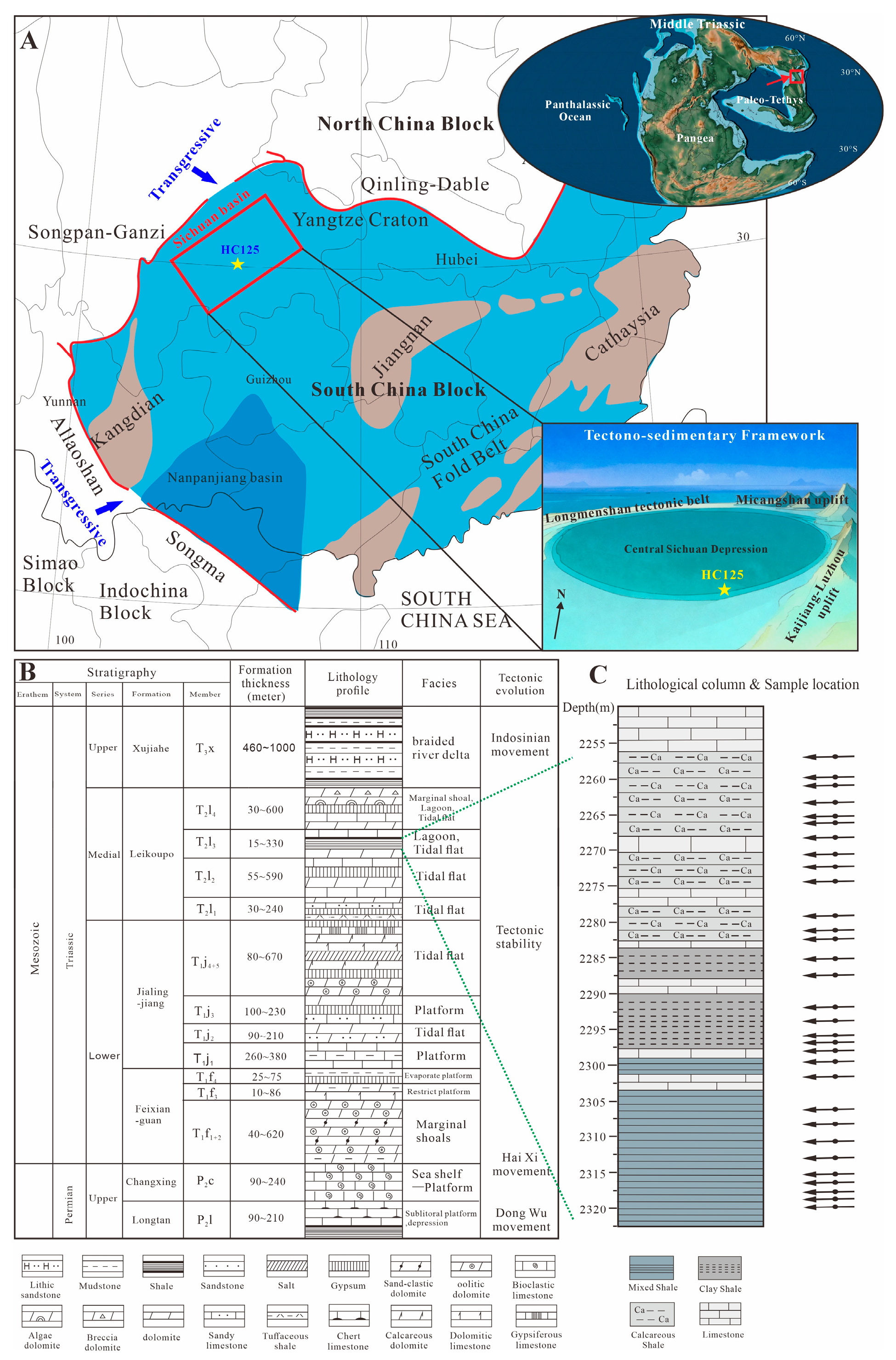

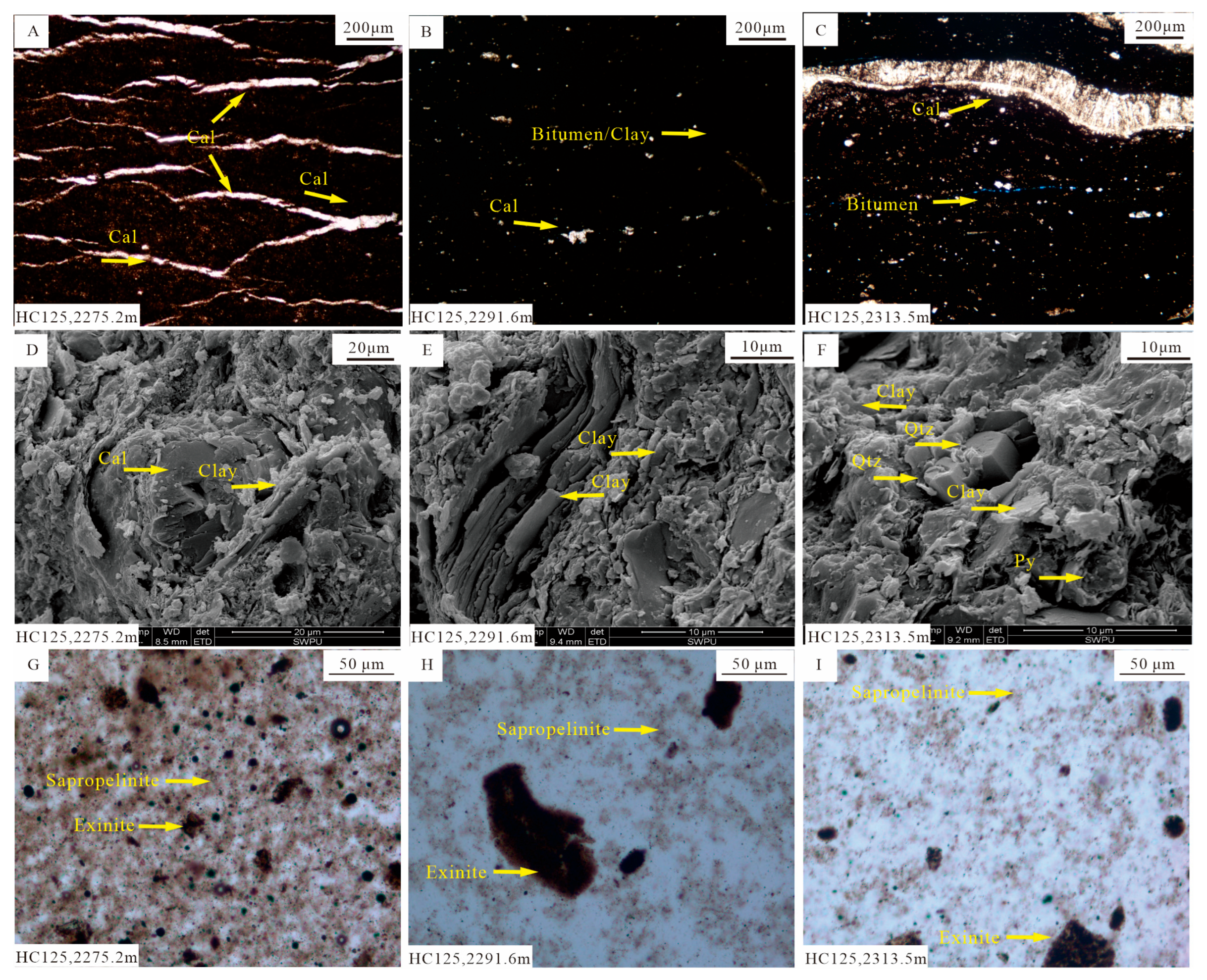
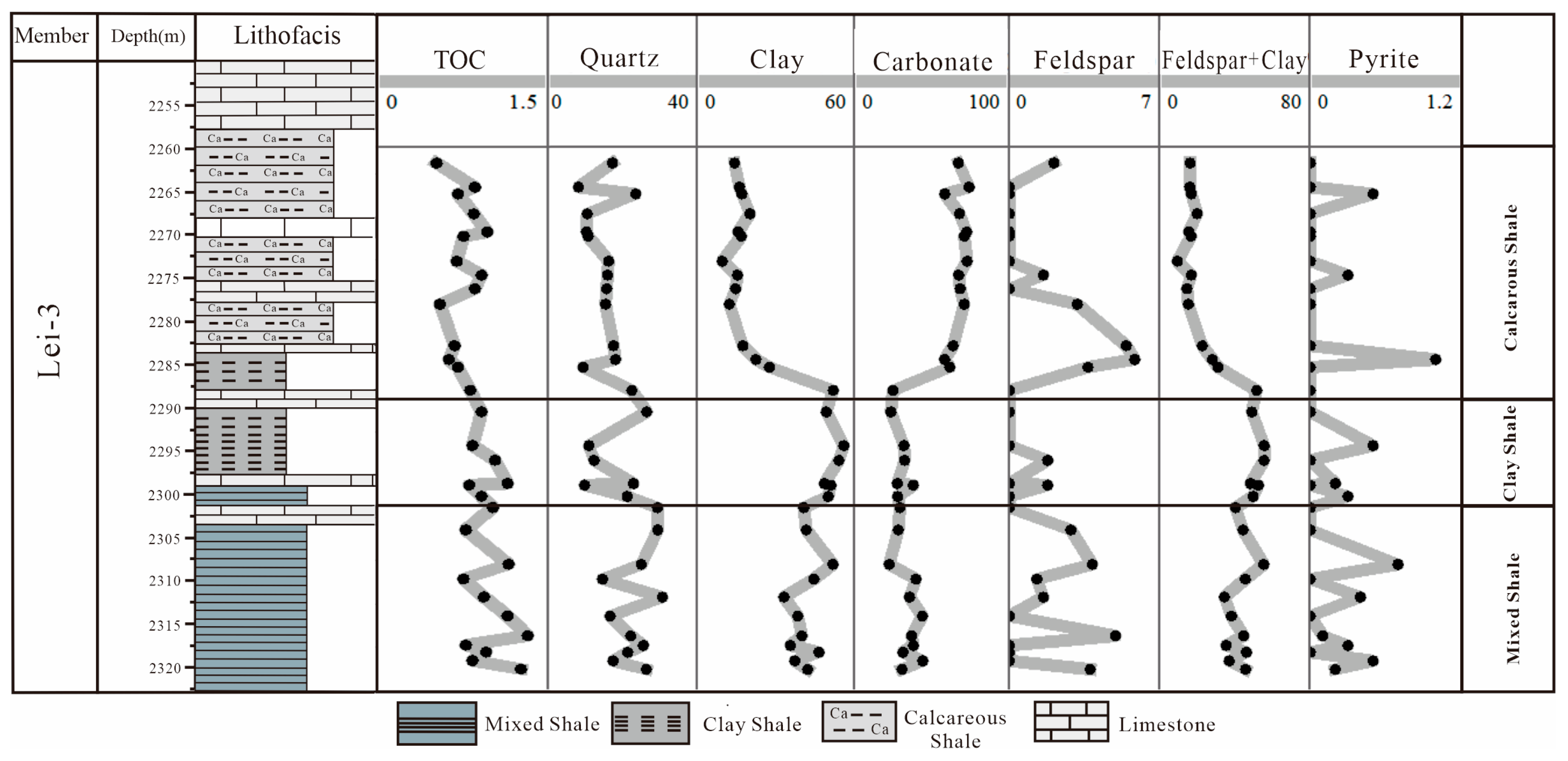



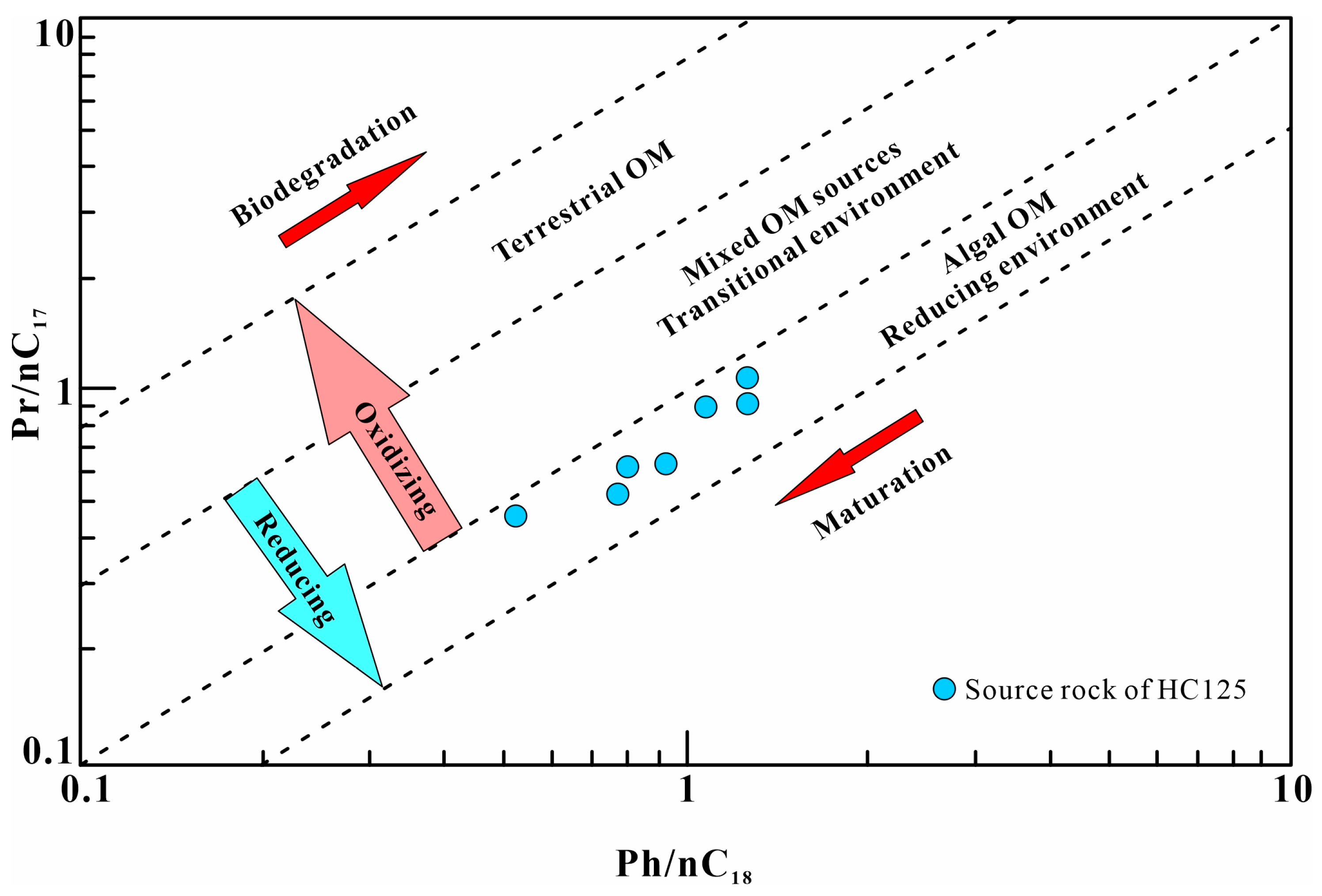



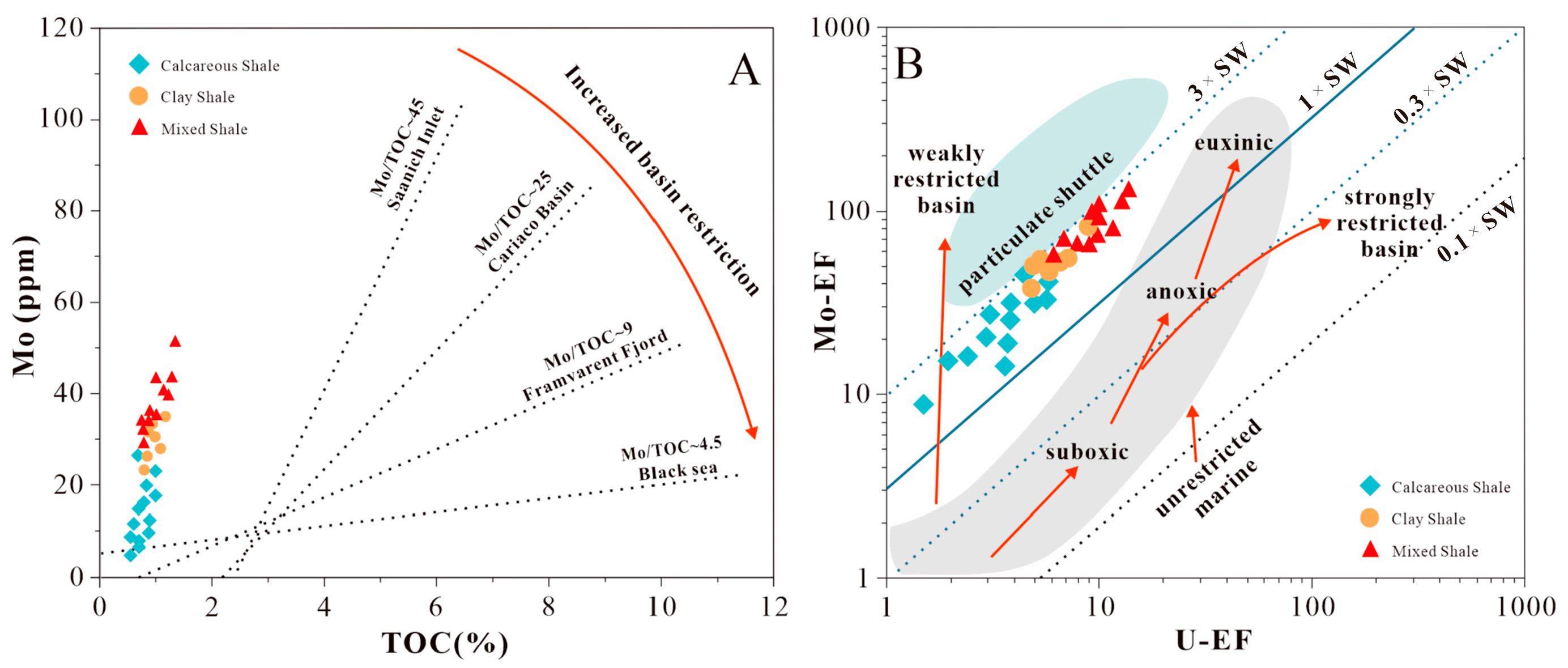
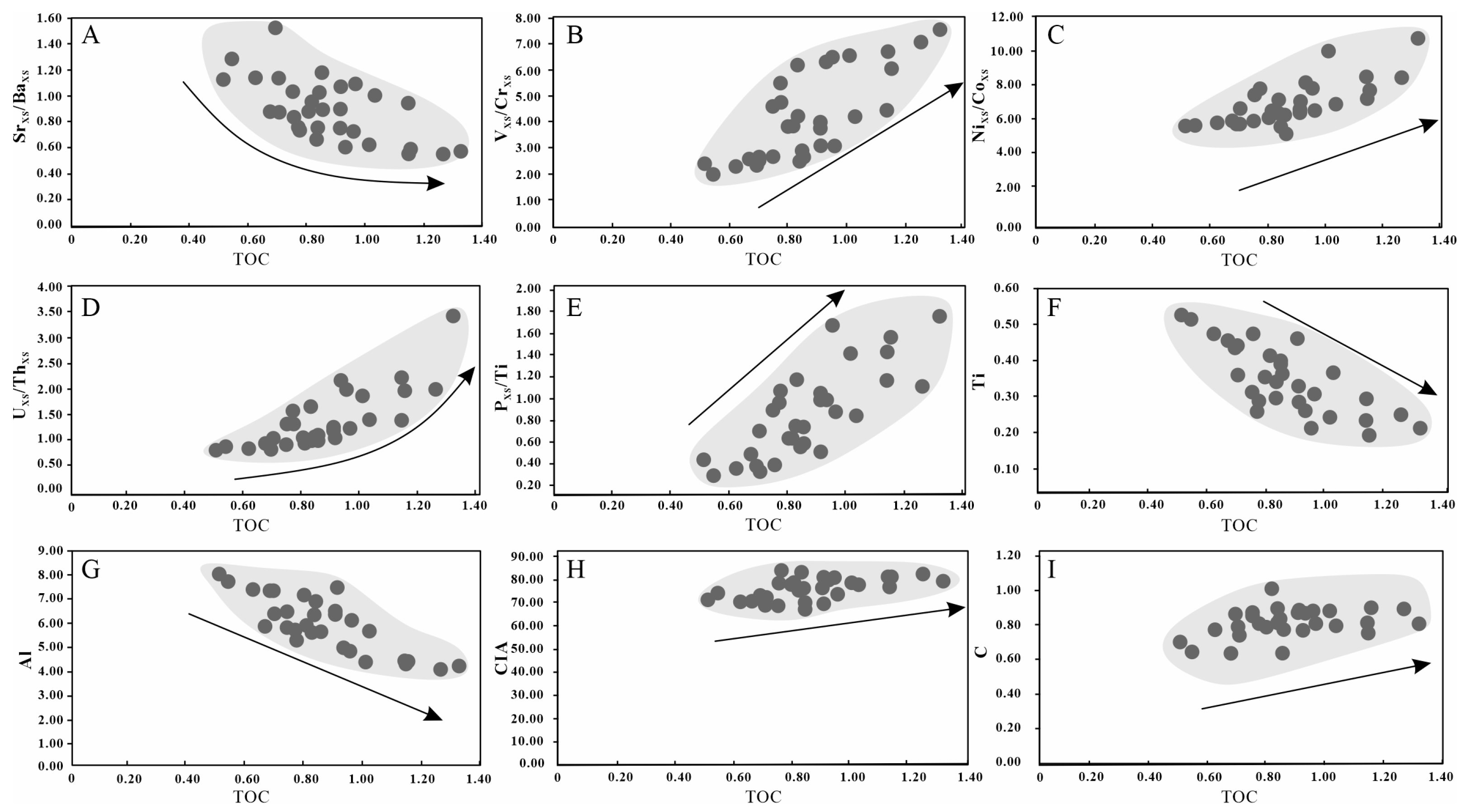
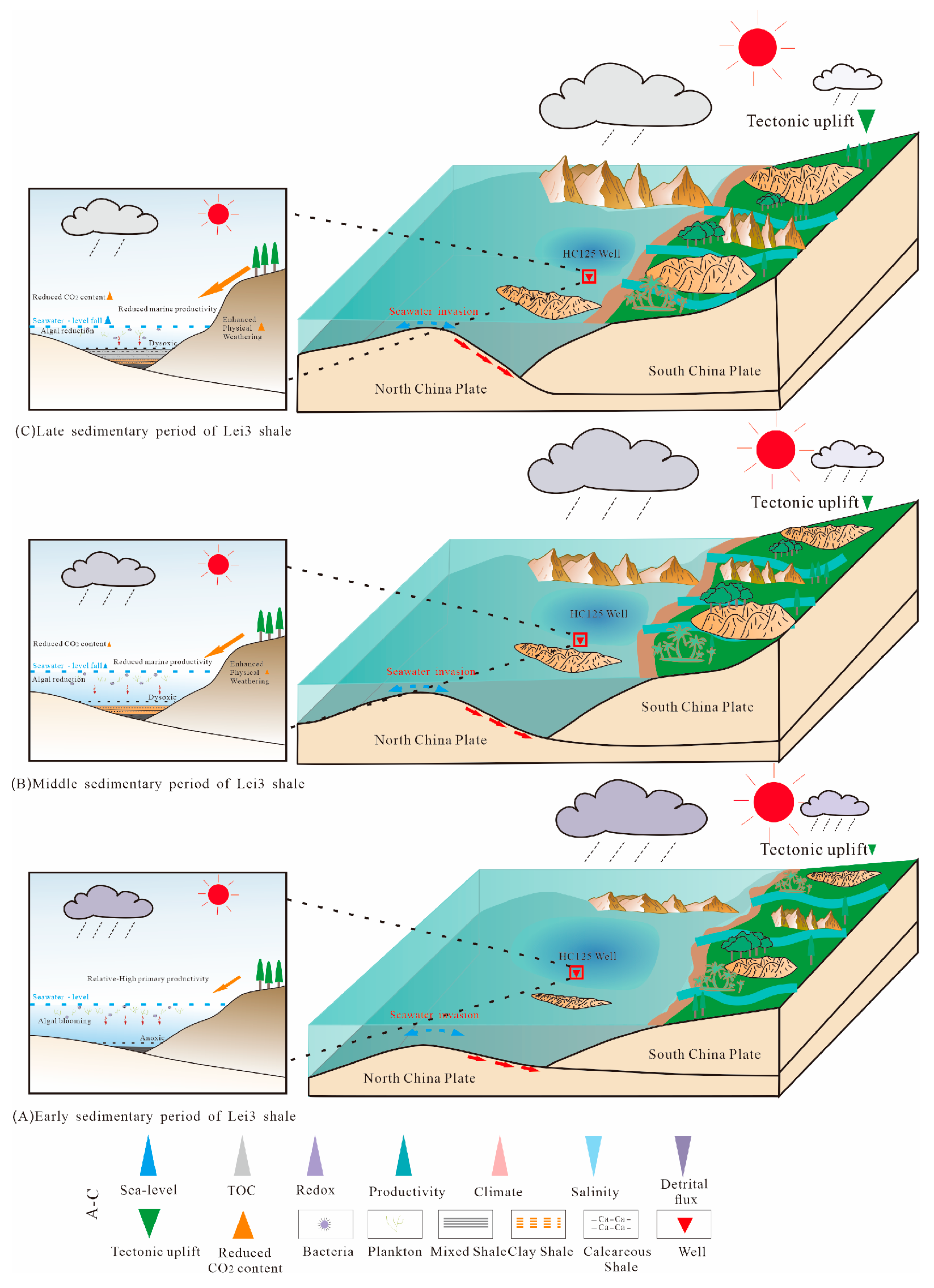
| Formation | Age | TOC (wt%) | S1 (mgHC/g Rock) | S2 (mgHC/g Rock) | Tmax (°C) | HI (mg HC/g TOC) | OI (mg CO2/g TOC | Reference |
|---|---|---|---|---|---|---|---|---|
| Longmaxi fm. (China) | Lower Silurian | 0.34–4 | 0.02–0.05 | 0.26–0.48 | 313–601 | 8–38 | 8–69 | [69] |
| Niutitang fm. (China) | Lower Cambrian | 0.39–10.2 | 0.01–0.05 | 0.09–0.62 | 281–600 | 3–86 | 4–240 | [69] |
| Muskwa, Besa & Fort Simpson Fm. (Canada) | Devonian- Mississippian | 0.18–4.72 | 0.01–0.04 | 0.04–0.24 | 369–611 | 1–9 | 4–12 | [58] |
| Barnett Shale (USA) | Mississippian | 2.62–11.47 | 0.26–3.6 | 0.59–54.53 | 425–544 | 14–475 | [68] | |
| Gufeng Fm. (China) | Lower Permian | 0.04–22.1 | 0–0.31 | 0–7.95 | 339–554 | 0–60 | 3–429 | [70] |
| Montney Fm. (Canada) | Lower Triassic | 0.03–8.2 | 0.02–0.81 | 0–1.83 | 347–526 | 1–367 | 0–933 | [71] |
| Baling and Bendang Riang Fm. | Silurian-Devonian | 0.73–24.6 | 0.01–0.08 | 0.02–0.37 | 322–502 | 0.28–25.18 | 0.89–40.89 | [72] |
| Timah Tasoh and Sanai Fm. | Devonian | 0.1–9.1 | 0.01–0.07 | 0.02–0.14 | 330–502 | 0.55–110 | 2.79–900 | [72] |
| Kubang Pasu (Perlis), Singa, Batu Gajah Fm. | Carboniferous | 0.06–279 | 0.01–0.06 | 0.02–0.14 | 301–608 | 15–115.94 | 2.27–598.43 | [72] |
| Kubang Pasu (Kedah) Fm. | L. Permian | 1.01–19.65 | 0.01–0.05 | 0.02–0.09 | 328–502 | 0.21–3.33 | 4.27–15 | [42] |
| Leikoupo fm. (China) | Middle Triassic | 0.11–4.01 | 0.01–0.11 | 0.02–0.6 | 424–592 | This study |
Disclaimer/Publisher’s Note: The statements, opinions and data contained in all publications are solely those of the individual author(s) and contributor(s) and not of MDPI and/or the editor(s). MDPI and/or the editor(s) disclaim responsibility for any injury to people or property resulting from any ideas, methods, instructions or products referred to in the content. |
© 2025 by the authors. Licensee MDPI, Basel, Switzerland. This article is an open access article distributed under the terms and conditions of the Creative Commons Attribution (CC BY) license (https://creativecommons.org/licenses/by/4.0/).
Share and Cite
Du, Z.; Chen, D.; Huang, Y.; Yang, X.; Xu, Y.; Jiang, G.; Shi, S.; Ma, B.; Huo, F. Petrology and Geochemistry Features of the Middle Triassic Anisian Shale in Sichuan Basin, South China: Implications for Climatic and Environmental Condition Change. Minerals 2025, 15, 1230. https://doi.org/10.3390/min15121230
Du Z, Chen D, Huang Y, Yang X, Xu Y, Jiang G, Shi S, Ma B, Huo F. Petrology and Geochemistry Features of the Middle Triassic Anisian Shale in Sichuan Basin, South China: Implications for Climatic and Environmental Condition Change. Minerals. 2025; 15(12):1230. https://doi.org/10.3390/min15121230
Chicago/Turabian StyleDu, Zhenjing, Dongxia Chen, Yuhan Huang, Xiaomin Yang, Yaodong Xu, Guanbo Jiang, Shilong Shi, Bingjie Ma, and Fei Huo. 2025. "Petrology and Geochemistry Features of the Middle Triassic Anisian Shale in Sichuan Basin, South China: Implications for Climatic and Environmental Condition Change" Minerals 15, no. 12: 1230. https://doi.org/10.3390/min15121230
APA StyleDu, Z., Chen, D., Huang, Y., Yang, X., Xu, Y., Jiang, G., Shi, S., Ma, B., & Huo, F. (2025). Petrology and Geochemistry Features of the Middle Triassic Anisian Shale in Sichuan Basin, South China: Implications for Climatic and Environmental Condition Change. Minerals, 15(12), 1230. https://doi.org/10.3390/min15121230








